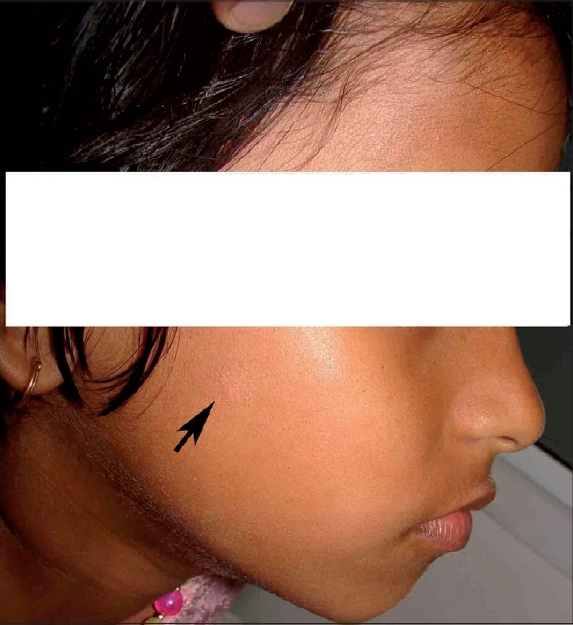Translate this page into:
Xerosis and pityriasis alba-like changes associated with zonisamide
Correspondence Address:
Feroze Kaliyadan
Department of Dermatology, Amrita Institute of Medical Sciences, Kochi - 682 026, Kerala
India
| How to cite this article: Kaliyadan F, Manoj J, Venkitakrishnan S. Xerosis and pityriasis alba-like changes associated with zonisamide. Indian J Dermatol Venereol Leprol 2008;74:165-166 |
 |
| Figure 1: Pityriasis alba like lesions on face |
 |
| Figure 1: Pityriasis alba like lesions on face |
Sir,
We would like to report a case of a 5-year-old child who developed extensive xerosis and pityriasis alba-like changes 2 months after she was started on zonisamide for West′s syndrome. Zonisamide is known to induce hypohidrosis, which we assume to be the underlying reason for the sudden development of xerosis in this case.
The patient presented to us with a history of generalized dryness and asymptomatic hypopigmented lesions on her face and trunk, which had started developing over the previous one month. She was under treatment from a neurologist for West′s syndrome for which she had been started on zonisamide 3 months previously. She was not on any other medication at the time of presentation. There was no history of any dry skin or any other significant skin disease in the past. Other than the seizure disorder, the patient was in good health. There was no personal or family history of atopy. On questioning, the mother mentioned an apparent decrease in sweating over the previous 1-2 months.
On examination, there was generalized dryness of the skin, which was more pronounced over the extremities. Hypopigmented macules of variable definition with minimal scaling were seen over the face [Figure - 1] and trunk. Some lesions showed mild erythema. Nails and hair were normal. Potassium hydroxide smears from the hypopigmented lesions were negative, and Wood′s lamp examination did not show any accentuation. A clinical diagnosis of xerosis and pityriasis alba-like changes was made. The patient was managed with emollients and vitamin supplements. Zonisamide was stopped and the patient was started on alternative anti-epileptic treatment, following which the dryness and the skin lesions improved.
Zonisamide is a relatively newer anti-epileptic drug that acts by the inhibition of carbonic anhydrase. [1] Both zonisamide and topiramate (another anti-epileptic that is also a carbonic anhydrase inhibitor) have been documented to cause hypohidrosis. [2],[3],[4],[5] Zonisamide has also been implicated in the causation of heat stroke in children secondary to oligohidrosis. [6] However, hypohidrosis is considered to be completely reversible after cessation of the drug. [6],[7] The exact mechanism of oligohidrosis due to these drugs remains conjectural, although it has been postulated that carbonic anhydrase blockage at the level of the sweat gland may be a major factor. [7] In our case, we assume that hypohidrosis induced by zonisamide contributed to the sudden development of xerosis and pityriasis alba-like changes. Pityriasis alba itself is known to be precipitated by dryness of the skin. [8] This report highlights the point that in patients on zonisamide or topiramate presenting with sudden onset of dryness of the skin, the possibility of drug-induced hypohidrosis should be considered.
| 1. |
Leppik IE. Zonisamide: Chemistry, mechanism of action and pharmacokinetics. Seizure 2004;13:5-9.
[Google Scholar]
|
| 2. |
Okumura A, Ishihara N, Kato T, Hayakawa F, Kuno K, Watanabe K. Predictive value of acetylcholine stimulation testing for oligohidrosis caused by zonisamide. Pediatr Neurol 2000;23:59-61.
[Google Scholar]
|
| 3. |
Knudsen JF, Thambi LR, Kapcala LP, Racoosin JA. Oligohydrosis and fever in pediatric patients treated with zonisamide. Pediatr Neurol 2003;28:184-9.
[Google Scholar]
|
| 4. |
Low PA, James S, Peschel T, Leong R, Rothstein A. Zonisamide and associated oligohidrosis and hyperthermia. Epilepsy Res 2004;62:27-34.
[Google Scholar]
|
| 5. |
de Carolis P, Magnifico F, Pierangeli G, Rinaldi R, Galeotti M, Cevoli S, et al . Transient hypohidrosis induced by topiramate. Epilepsia 2003;44:974-6.
[Google Scholar]
|
| 6. |
Shimizu T, Yamashita Y, Satoi M, Togo A, Wada N, Matsuishi T, et al . Heat stroke-like episode in a child caused by zonisamide. Brain Dev 1997;19:366-8.
[Google Scholar]
|
| 7. |
Cerminara C, Seri S, Bombardieri R, Pinci M, Curatolo P. Hypohidrosis during topiramate treatment: A rare and reversible side effect. Pediatr Neurol 2006;34:392-4.
[Google Scholar]
|
| 8. |
Vinod S, Singh G, Dash K, Grover S. Clinico epidemiological study of pityriasis alba. Indian J Dermatol Venereol Leprol 2002;68:338-40.
[Google Scholar]
|
Fulltext Views
2,732
PDF downloads
2,077





